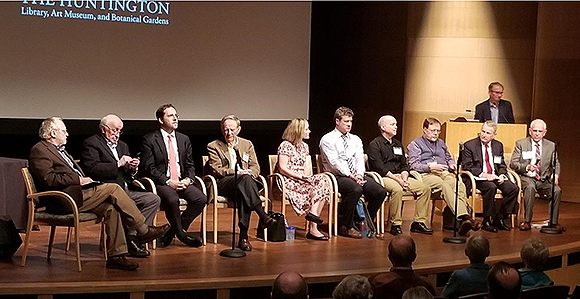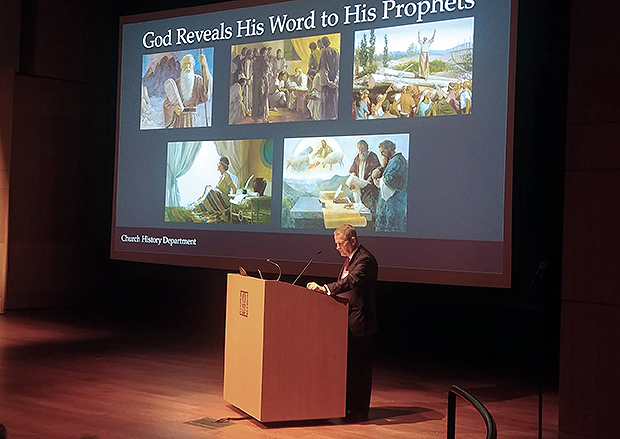Church Historian and Recorder Speaks on Significance of First Vision at Huntington Library Conference
Contributed By Grace Carter, Church News staff writer

Religious scholars participate in the closing panel discussion of a conference called “The First Vision of Joseph Smith, Jr.: 200 Years On” at the Huntington Library, Art Museum, and Botanical Gardens in San Marino, California, on January 25, 2020. Photo by Alex Baugh.
Article Highlights
- God hears and answers prayers asked with faith.
- God is willing to reveal His will to mortals, as He did in biblical times.
- God’s nature is merciful, and the Godhead comprises three distinct personages.
- After the general Apostasy prophesied in the Bible, the Restoration of the gospel began with Joseph Smith’s First Vision.
Related Links
The Huntington Library, Art Museum, and Botanical Gardens in San Marino, California, is known for its sumptuous landscaping and extensive collections of art and historical documents.
Among its more than 11 million items, this research institution in Los Angeles County houses thousands of books and manuscripts related to the history of The Church of Jesus Christ of Latter-day Saints. This collection—which spans from about 1805 through the 20th century—includes Oliver Cowdery’s 1834–1838 letterbook, original letters by Joseph Smith, and the diaries of early Latter-day Saint women such as Eliza R. Snow and Lucy Mack Smith.
Drawing on this vast catalog of Church history materials, the Huntington hosted “The First Vision of Joseph Smith, Jr.: 200 Years On”—a two-day conference held January 24 and 25 commemorating the 200th anniversary of Joseph Smith’s First Vision.
The conference featured 12 religious scholars—including members of the Church and those of other faiths—and was organized and conducted by Steve Hindle, the Huntington’s director of research, and Richard E. Bennett, a professor at Brigham Young University.
Participants addressed topics such as the character of the Prophet Joseph Smith; changing emphases of the First Vision over the past 200 years; controversies and differing accounts of the First Vision; the form and power of godliness; the historical context of Joseph Smith’s experience; and women’s spiritual communications from the same time period.
Elder LeGrand R. Curtis Jr., a General Authority Seventy serving as Church Historian and Recorder and executive director of the Church History Department, delivered the conference’s keynote address.
Noting that Joseph Smith’s experience is consistent with the biblical pattern of God revealing truth through prophets, Elder Curtis outlined four theological truths that Latter-day Saints derive from the First Vision:
- God hears and answers prayers asked with faith.
- God is willing to reveal His will to mortals, as He did in biblical times.
- God’s nature is merciful, and the Godhead comprises three distinct personages.
- The general Apostasy prophesied in the Bible occurred, and the Restoration of the fulness of the gospel of Jesus Christ began with Joseph Smith’s First Vision.
These key truths constitute the beginning of many revelations received by the Prophet Joseph Smith, Elder Curtis said. One of those revelations came when the Church was organized on April 6, 1830. The first words of this revelation, now contained in Doctrine and Covenants 21, state, “Behold, there shall be a record kept among you.”
“Since that time,” Elder Curtis said, “Latter-day Saints have taken seriously what we regard as a divine charge to keep a record.”
He added that the Church History Department fulfills this charge by collecting, preserving, and sharing materials related to Church history.

Elder LeGrand R. Curtis Jr., a General Authority Seventy and executive director of the Church History Department, presents the keynote address at a conference called “The First Vision of Joseph Smith, Jr.: 200 Years On” at the Huntington Library, Art Museum, and Botanical Gardens in San Marino, California, on January 24, 2020. Photo by Alex Baugh.
Published Accounts of the First Vision
One of the ways the Church shares the First Vision story is through the Pearl of Great Price, one of the four volumes that Latter-day Saints consider holy scripture. Elder Curtis noted that although this account—dictated by Joseph Smith in 1838—is the canonical version of Joseph Smith’s First Vision, the Church has also published other accounts.
The Gospel Topics Essay titled “First Vision Accounts” is available on the Church’s website and contains links to all known accounts of the First Vision, Elder Curtis said.
“Some have interpreted the variations in the accounts as evidence that Joseph embellished his experience over time or that he manufactured the experience later in his life to bolster his religious authority,” he said. “However, many scholars ... do not interpret the differences as evidence that the vision did not happen when and how Joseph Smith said it did.”
Elder Curtis explained that many scholars expect the details and emphases of different accounts to vary depending on Joseph’s audience and the occasion for sharing his experience over the years.
He added that he interprets the variation among Joseph’s accounts as evidence of the Prophet’s “inability to adequately describe his experience, which is something he mentioned and lamented repeatedly. I believe that the accounts, taken as a whole, are harmonious and that the differences are expected rather than a cause to suspect that Joseph did not experience a vision of divine beings.”
The Church has also shared the story of the First Vision in publications such as Saints: The Story of the Church of Jesus Christ in the Latter Days—a narrative history whose first volume was published in 2018—and The Joseph Smith Papers, a compilation of primary documents related to the Prophet’s life. Both of these resources are available online.
“We are going to great lengths to make all documents related to the First Vision accessible,” Elder Curtis said of the Church History Department.

Steve Hindle, director of research at the Huntington Library, poses for a photo with the 12 religious scholars who participated in a conference called “The First Vision of Joseph Smith, Jr.: 200 Years On,” held at the Huntington Library, Art Museum, and Botanical Gardens in San Marino, California, on January 24 and 25, 2020. Photo by Richard E. Bennett.
Missionary Work
Aside from publishing written accounts, the Church relies on missionaries to share the story of the First Vision with those interested in learning about the restored gospel of Jesus Christ.
Elder Curtis said in the early days of the Church, missionaries usually began teaching potential converts by telling them about the publication of the Book of Mormon.
However, “in the second half of the 19th century, as agnosticism and atheism spread across the Western world, teaching about the First Vision increased in importance,” he said. “It was viewed as an important part of our ministry that we testify that God had personally appeared to a modern prophet.”
Today, he added, full-time missionaries tell millions of people about the First Vision in their own language every year—often during their first encounter. We are going to great lengths to make all documents related to the First Vision accessible.
Elder Curtis recalled the power he felt in sharing Joseph Smith’s account with people in Italy when he served there as a young missionary and later witnessing its importance in the conversion experiences of people in West Africa, where he served as Area President.
He quoted a Ghanaian member of the Church, Freebody Mensah, who wrote the following about reading a pamphlet on the First Vision in 1984: “I was spellbound after reading and could not sleep the whole night.” Many converts to the Church have experienced similar feelings after reading or hearing Joseph Smith’s account of his First Vision, Elder Curtis said.
Immersive Experiences
The Church also maintains sites for visitors to come and experience the story of the First Vision for themselves. One of these sites is the Church History Museum in Salt Lake City, where a permanent exhibit includes a stained glass window depicting God the Father and Jesus Christ appearing to Joseph Smith, as well as artifacts and documents from early Church history.
Elder Curtis described the seven-minute immersive film experience available at the museum, which “takes viewers into the grove with young Joseph, and they witness the events as recorded in the various accounts of the First Vision.” He then played a flat-screen version of the video for the conference attendees.
The Church also owns and maintains the Sacred Grove in upstate New York, where the Smith family lived at the time Joseph received his First Vision.
After the Church purchased the property in 1907, members began to hold religious services and other meetings in the Sacred Grove. Over time, however, the benches, pulpit, and sound system were removed “to help the grove look and feel, as much as possible, as it would have looked and felt in 1820 when the First Vision took place,” Elder Curtis said.
Now the Sacred Grove is a place reserved for quiet reflection on the sacred theophany that occurred there.
All of these efforts are part of the Church’s work to share a critical moment in its history, Elder Curtis said.
“Millions of people around the globe have been impacted for good by [the First Vision] as it has been shared by Joseph Smith and the Church that was restored through him,” he added. “I am one of those millions.”
Other speakers at the conference included Bennett (one of the conference organizers), professors Richard L. Bushman from Columbia University, George M. Marsden from the University of Notre Dame, Kathleen Flake from the University of Virginia, Richard J. Mouw from Fuller Theological Seminary, David F. Holland from Harvard University, Rachel Cope from BYU, John H. Wigger from the University of Missouri, Steven Harper from BYU, Ann Taves from the University of California at Santa Barbara, and Peter J. Blodgett, curator of the Huntington Library.
A recording of the conference will be available for viewing on the Huntington’s website in a few weeks, and the proceedings will be published this year in the journal BYU Studies.
